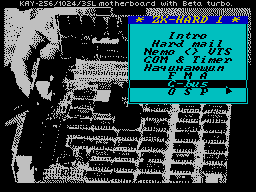|
ZX Hard #01
06 мая 1999 |
|
C-bus - bus is founded on the Centronics interface.

C-bus (based on Centronics interface).
(C) VTS'99
The idea is simple: the device, intending to
for a long time to settle on the external bus,
should have input and output, and included
cascade. Printer - the last one.
So, there are 8 buffered outputs for the printer is the
data. For bidirectional communication, they do not fit, then
let it be a control line. These lines are broadcast directly to
the output without buffers.
Still has 8 bidirectional lines.
This, of course, the data bus. In fact,
They also nehily (go to muzykalki), but
if they are properly loaded, or if you desperately need a long
train, will have buffered. Here we have needed a flag RD / WR.
Take on his role OK output Q2 / (SLCTIN, 17pin_DB25). Active
(zero) level corresponds to the reading. Of course, if you can
programmatically get the conflict, but from the idiots still
can not escape, and mikruhi such things generally do not fear.
If the device is very simple, with short
input train and the only load
(1,533.555) on this bus, the buffer is not required. Otherwise
it is better protranslirovat data to exit through the AP6,
filed for 1'uyu leg flag RD / WR.
Well, it now remains to understand how
select the desired device. Of the remaining five
OK-O one occupied by the printer, and one
determines the direction of data transmission.
However, strobe the printer can also be used, but such a device
is activated instead of the printer, and also the latest in a
chain.
Thus, there are 3 OK, that is, You can connect
to 3'eh devices at a time, not counting
printer.
To not fight for the address
space, you can do so. All Soup chosen through Q6, but each of
them translates these lines as follows:
Q5 Q5 Q5 Q5 Q5 Q5 <--- p
- R
Q2 Q2 Q2 Q2 Q2 Q2 i
n
Z <-Q6 / Q6 <-
Other articles:
Similar articles:
В этот день... 31 December